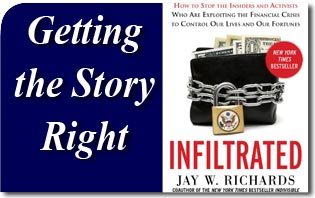 A review of Infiltrated:How to Stop the Insiders and Activists Who are Exploiting the Financial Crisis to Control Our Lives and Our Fortunes (McGraw-Hill Professional, August 2013) by Dr. Jay Richards written by John Horvat II.
A review of Infiltrated:How to Stop the Insiders and Activists Who are Exploiting the Financial Crisis to Control Our Lives and Our Fortunes (McGraw-Hill Professional, August 2013) by Dr. Jay Richards written by John Horvat II.
All too often economic decisions are not determined by the facts on the ground but by the way facts are perceived. The situation is made worse when perceived facts are put together in a narrative that delivers an account diametrically opposed to reality. In such cases, who controls the narrative, controls public policy.
Jay Richard’s masterful new book Infiltrated is a story that unmasks the false narrative that came out of the 2008 sub prime mortgage crisis. He manages to untangle the labyrinth of people, places and organizations that threw the nation into crisis and almost brought down the system. The book is a who’s who of the key characters that were involved in the crisis.
However, more importantly, the book sets the facts straight and tells a true narrative of what actually happened. The author dispels the popular belief among media and the public that the greedy actions of big banks caused the crisis. Now, five years afterward, Richards casts a wide net to sift through the confusion and expose some of the principal characters that orchestrated the crisis that began in September 2008. He provides a socioeconomic analysis of what happened and examines the continuing debate over who is to blame for the crisis and who is still trying to gain from it.
Perhaps the message of the book is best described by its long subtitle: How to Stop the Insiders and Activists Who are Exploiting the Financial Crisis to Control Our Lives and Our Fortunes. In other words, the story is hardly over. The false narrative still continues and controls public policy. Richards especially focuses on the Dodd-Frank Act, which adds tens of thousand of pages of regulations on financial institutions based on a false understanding of the crisis.
“That false understanding provided the motivation for passing the Dodd-Frank Act, which supporters claimed would prevent a future financial crisis,” Richards says. “But the facts show otherwise—and the truth is far more insidious. It is only by understanding the real cause of the crisis that we can prevent another one.”
The real story, Richards claims, is a terrible tale of catastrophic and misguided government policies, loan brokers, media and activist groups that actually created a market for risky loans and led to the mammoth housing bubble in 2008. It was a vast network of liberal groups and individuals that loosened lending standards to an unprecedented degree. Richards gives the example of how only 1 in 200 mortgages had a down payment of 3 percent or less in 1990. By 2007, it was one in three. It was no wonder the system came tumbling down.
However, the danger remains grave. Richards argues: “What few realize is that the same politicians and activists who crafted these destructive policies have used the crisis to continue those policies and increase their power over the financial sectors of our economy. These include sectors far removed from mortgages and will affect the financial well-being of every American.”
That is why books like Infiltrated are so important. They create awareness of what went wrong and how to avoid such mistakes in the future. In addition, Richards provides a chapter with practical steps about what can be done to put America back on course. However, he warns that if such lessons are not learned, America may be setting itself up for a future crisis that will dwarf the calamity of 2008.
The first and most important step is to unmask the false narrative about the present economic crisis. Infiltrated and other books like it do a great service by making it clear where the blame lies. Best of all, they help Americans get the story right.

